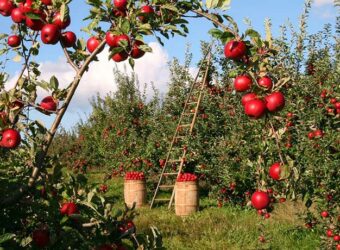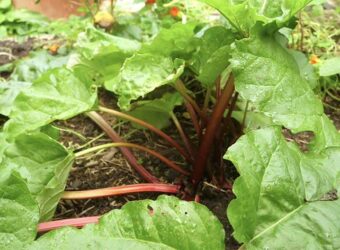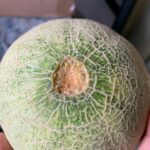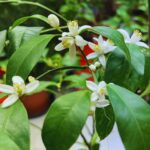Blueberry bushes produce delicious fruit that birds, animals, and people love. The blueberry bush can live up to 50 years if taken care of, so plant one where it can stay for that long. Here is what you need to know about blueberry growth stages.
Important Blueberry Facts
| Scientific Name | Vaccinium (the second word varies by species of blueberry) |
| Type of plant | Perennial bush |
| Part Eaten | berry |
| Days to Harvest | 2-3 years from seed |
| Season Grown | Summer, fall, depending on climate and species |
| Cooked or raw | either |
| Optimal pH | 5.0-5.5 |
Blueberry bushes are either Rabbiteye (Vaccinium virgatum), Northern highbush (Vaccinium corymbosum), or Southern highbush (Vaccinium hybrid). Each grows in a different habitat. There are several different cultivars, or varieties, within each species of blueberry. Blueberry bushes are perennials, meaning they live many years. It takes a plant two to three years to start producing berries. While most blueberries will self-pollinate, the yields are greater if you plant two different varieties. Blueberries are ready in summer or early fall, depending on the climate and type of blueberry. Blueberries prefer acidic soil with a pH of 5.0-5.5. They do not grow well or produce in soil with a pH outside that range.
Blueberry Growth Stages
| Growth Stage | Days after Planting For the Stage to Start* |
| Germination | 0 |
| Seedling | 30 |
| One Year bush | 365 |
| Two Year bush | 720 |
| Third Year and after | 1,085 |
Starting a Blueberry Bush
Blueberries can be started from seeds or from cuttings.
Planting Seeds
Seeds are planted in the early spring. Before planting, the blueberries must be frozen for at least 90 days. The seeds will not germinate until they have been frozen. Remove the pulp from the seeds and wash until they are bare. Plant them in a nursery area that is protected and where they can grow for a year or two. It takes the seed about thirty days to germinate or start growing.
Cuttings
Cuttings are taken in January or February. They are usually about four inches long and are rooted in ground peat moss that has been soaked for three to four hours before planting. The cuttings must be protected from the cold by a cold frame or greenhouse to keep them from freezing.
Becoming Seedlings
The plants become seedlings once the plant embryos from seed break the surface of the soil or when the cuttings are planted. This stage is characterized by the development of roots and leaves. Seedlings are vulnerable to being eaten by rabbits or deer, to other pests, and to diseases. Because the plants are young, they do not have the ability to resist diseases as well as older plants.
One Year Bush
Many one-year-old bushes are sold as bare-root plants. These are planted in January or February, while they are dormant. While they have roots, it takes time for those roots to become established so they can support the rest of the plant. It is a good idea to remove flower buds from these bushes the first two years after they are planted.
Two Year Bush
Many potted blueberry plants are sold as two-year-old bushes. They are generally planted in the fall to give their roots time to become established before the winter. However, potted blueberry bushes can be planted at any time of the year. Flower buds should be removed from these bushes the first year they are planted.
Three Year Bushes and Beyond
Bushes that are three years old are generally old enough to support berries. There are twenty-one stages a blueberry bush goes through during the year. These are generally defined by the state of the flower bud or fruit, although a couple refer to the leaves. These stages are important when using pesticides on the blueberry bush. Certain pesticides are used at different stages to combat pests that frequent that stage or later stages. If you garden organically, this is not as important. Most home gardeners, even ones gardening with synthetic products, will not spray their bushes as often as commercial growers do. The timing of fertilizers may also be directed by the stage of the flower or shoot during the year. Again, this is more important for commercial growers than for home gardeners. I mention all these stages because you will read about them in Extension publications and should know what they are talking about.
Stages of the Blueberry During the Year
| Stage | Characteristics |
| Dormant or tight bud | Bud tightly furled, no swelling, goes through winter like this. |
| Bud Swell | Visible swelling of the flower buds; outer bud scales begin to separate at the tip revealing paler interior bud scales. |
| Early green tip | Bud scales are separating at leaf bud tips. Green leaf tissue is emerging from the leaf bud tips. From 1/16 to 3/16 inch (2 to 5 mm) of green tissue is exposed. Leaves are tightly rolled. |
| Bud break or bud burst | Small green berries are expanding. Fruit in the cluster varies from large to small pea-sized. Early fruit growth is by cell division. |
| Late green tip | Leaves are beginning to unfold. More green leaf tissue is visible, ¼ to ½ inch (6 – 13 mm). This stage generally occurs around flower bud burst. |
| Tight cluster | Individual flowers are distinguishable in the flower cluster. |
| Shoot expansion | Multiple leaves have emerged from the vegetative buds and unfolded. Leaves are enlarging and shoot growth has begun. |
| Early pink bud | Expanding flowers are readily visible and have separated. The pink corolla tubes (petals) are short and closed. |
| Late pink bud | Individual flowers fully developed. Expanded corollas are now white but still closed. |
| Early bloom | Some of the corollas are completely expanded and open. Many flowers are still closed. |
| Full bloom | Most of the flowers on the bush have opened. |
| Petal fall | The corolla tubes are falling off the flowers, revealing small green fruit. This is the most vulnerable stage to freeze injury. Damage can occur at 32⁰F (0⁰C). |
| Early green fruit | Growth of large fruit slows. The fruit becomes pale green. Exposed fruit may develop a red blush. |
| Late green fruit | The oldest, largest fruit in the cluster begins to change color from green to pink to blue. Fruit begins to soften. Cell division has stopped and fruit growth is by cell expansion. |
| Shoot tip set | The oldest, largest fruit in the cluster begins to change color from green to pink to blue. Fruit begins to soften. Cell division has stopped, and fruit growth is by cell expansion. |
| Fruit coloring | The oldest, largest fruit in the cluster begins to change color from green to pink to blue. Fruit begins to soften. Cell division has stopped, and fruit growth is by cell expansion. |
| 10% blue | Single berries in the fruit clusters are ripe and ready to harvest. About ten percent of the fruits, on a bush or in the field, are ready to harvest. |
| 25% blue | After harvest, the blueberry bush stores reserves for next year’s growth. Shoot growth may begin again. Flower buds for next year’s crop form |
| 75% blue | Blueberries are picked several times as the fruit ripens with 2 to 5 pickings. This stage is when the first mechanical harvesting takes place on commercial farms. |
| Fruit bud set | After harvest, the blueberry bush stores reserves for next year’s growth. Shoot growth may begin again. Flower buds for next year’s crop form. |
| Fall color | At the end of the growing season, the leaves change color as nutrients are mobilized back into the shoots for growth next spring. |
Fruit Production
Plants will produce about one-half pound of berries in the third year. They will produce one to two pounds of berries in the fourth year. After that, a well-taken-care-of rabbiteye bush will produce 12-25 pounds of fruit, and a highbush will produce around eight pounds of fruit a year. Blueberries are at full production when they are six to eight years old.
Fruit Storage
Blueberries that will be consumed soon may be kept in the refrigerator for three to five days. Blueberries can also be frozen or canned. Of course, they can be cooked into pies, cobblers, and many other delicious recipes.
Chilling Hours
Blueberries know when to start bud swell and subsequent stages by how long they have been cold. This time being cold is referred to as chilling hours. Different varieties need different amounts of chilling hours to begin spring growth. The number of chilling hours of the varieties you plant must be matched with the number of chilling hours that your county gets. If you plant varieties that need fewer chilling hours than your county gets, the buds will start to swell too early, and the flowers will probably freeze. You won’t get any blueberries from those flowers. If the chilling hours the plant needs are too much more than what your area receives, then your blueberries will never bloom. Your county Extension agent can tell you how many chilling hours your area gets. I have found that global warming is changing the number of chilling hours my county receives, so the variety of blueberries I plant has changed, too. Check to see what the current number of chilling hours are in your area because they may have changed, too.
In conclusion, blueberries are started from seed or cuttings. They are raised in a nursery area for the first one to two years of their life. Bare root plants are usually one year old and planted in late winter. Potted blueberries are usually two years old and are planted in the fall. Flower buds should be removed until the bush is three years old. A blueberry bush goes through twenty-one distinct stages each year. These stages are primarily important to commercial growers but may guide homeowner applications of pesticides and fertilizer, as well.






